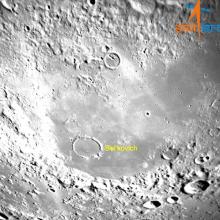Listen to today's episode of StarDate on the web the same day it airs in high-quality streaming audio without any extra ads or announcements. Choose a $8 one-month pass, or listen every day for a year for just $30.
You are here
Moon and Aldebaran
As seen from most of the United States, the beautiful crescent Moon will just squeak past the bright star Aldebaran early tomorrow. They’ll be separated by no more than a degree or two as they climb into view a couple of hours before sunrise. And from northern Minnesota and parts of Canada, the Moon will pass in front of the star, briefly blocking it from view.
Such a passage is known as an occultation. And over the last century or two, astronomers have used occultations to learn more about the stars the Moon covers up, and about the Moon’s orbit around Earth.
Precise timing of an occultation reveals the Moon’s exact position in the sky. That can be used to refine models of the Moon’s orbit. That helps get spacecraft to the Moon, and helps refine our understanding of gravity.
Occultations also can help astronomers measure the size of a star. Timing just how long it takes a star to disappear behind the Moon reveals its angular diameter -- how big it looks in the sky. When that’s combined with the star’s distance, that tells us how big the star really is.
Occultations also can tell us if a star has a companion. If there’s more than one star in a system, then the light fades away in steps. If there’s only one star, it fades smoothly.
For the most part, other techniques have replaced occultation measurements. Even so, astronomers still keep an eye on most occultations -- trying to learn just a little bit more about the Moon and stars.






